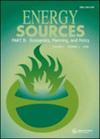A comprehensive model to explain consumers’ purchasing intention of energy-efficient household appliances: A case study in China
IF 2.2
4区 工程技术
Q3 ENERGY & FUELS
Energy Sources Part B-Economics Planning and Policy
Pub Date : 2023-10-02
DOI:10.1080/15567249.2023.2263006
引用次数: 0
Abstract
ABSTRACTGiven the significant increase in residential electricity consumption in China, promoting the use of energy-efficient household appliances in residential buildings is imperative. Considering this, we construct a new comprehensive model, including the theory of planned behavior (TPB) and Theory of value belief norms (VBN), to identify consumers’ intentions to purchase energy-efficient household appliances. The model is empirically tested using a structural equation modeling approach based on 891 effective questionnaires from Chinese respondents. The results show that TPB variables are important factors in predicting consumers’ intentions to purchase energy-efficient household appliances. Product cognition is the best predictor of purchasing intention, followed by perceived behavioral control, environmental awareness, and subjective norms. For VBN variables, the egoistic value and altruistic value placed on the awareness of consequence is insignificant; the other VBN variables all affect purchasing intention. Compared with the original TPB model or VBN model, this comprehensive model exhibits superior predictive ability in the purchase intention of energy-efficient household appliances. In this comprehensive model, environmental awareness creates a significant effect between the awareness of consequence and ascription of responsibility and the interactive influence of subjective norms on the personal norm. Finally, several important policy implications are documented.KEYWORDS: Energy-saving behaviorenergy-efficient household appliancesvalue-belief-norm theory AcknowledgementsWe are grateful for the financial support provided by the National Natural Science Foundation of China (No. 72074111)Disclosure statementNo potential conflict of interest was reported by the author(s).Notes1 National Energy Administration, http://www.nea.gov.cn/. (Accessed 26 May 2021).2 National Bureau of Statistics, http://www.stats.gov.cn/tjsj/ndsj/. (Accessed 03 October 2021).3 The energy-efficient household appliances mentioned in this study refer to high-efficiency home appliances with an energy efficiency level of 1 or 2.4 This study utilized an independent samples t-test since gender was a bicategorical variable. This study grouped age, income, and education level as multi-category variables for distinct groups to observe differences between groups. For example, the ages were classified into four categories: youth, prime-age, middle age, and old age. Four income categories are formed based on low, middle, upper-middle, and high-income levels. Thus, ANOVA was employed in the analysis.Additional informationFundingWe are grateful for the financial support provided by the National Natural Science Foundation of China (No. 72074111) and Major Program of National Fund of Philosophy and Social Science of China (No. 23ZDA111).消费者节能家电购买意愿的综合模型——以中国为例
【摘要】鉴于中国居民用电量的显著增长,在住宅建筑中推广使用节能家电势在必行。考虑到这一点,我们构建了一个新的综合模型,包括计划行为理论(TPB)和价值信念规范理论(VBN),以识别消费者购买节能家电的意愿。基于891份有效问卷,采用结构方程建模方法对模型进行实证检验。结果表明,TPB变量是预测消费者购买节能家电意愿的重要因素。产品认知是购买意愿的最佳预测因子,其次是感知行为控制、环境意识和主观规范。对于VBN变量,结果意识的利己主义价值和利他主义价值不显著;其他VBN变量均影响购买意愿。与原有的TPB模型或VBN模型相比,该综合模型对节能家电购买意愿的预测能力更强。在这个综合模型中,环境意识在后果意识和责任归属以及主观规范对个人规范的互动影响之间产生了显著的影响。最后,记录了几个重要的政策含义。关键词:节能行为节能家电价值信念规范理论感谢国家自然科学基金(No. 72074111)给予的资助披露声明作者未发现潜在利益冲突。注1国家能源局,http://www.nea.gov.cn/。(2021年5月26日生效国家统计局,http://www.stats.gov.cn/tjsj/ndsj/。(2021年10月3日生效)本研究中提到的节能家用电器是指能效水平为1或2.4的高效家用电器。由于性别是一个双分类变量,本研究采用了独立样本t检验。本研究将年龄、收入、受教育程度作为不同组别的多类别变量,观察组别间的差异。例如,年龄分为四类:青年、壮年、中年和老年。根据低收入、中等收入、中上收入和高收入水平划分了四个收入类别。因此,在分析中采用方差分析。感谢国家自然科学基金(No. 72074111)和国家哲学社会科学基金重大项目(No. 23ZDA111)的资助。
本文章由计算机程序翻译,如有差异,请以英文原文为准。
求助全文
约1分钟内获得全文
求助全文
来源期刊

Energy Sources Part B-Economics Planning and Policy
ENERGY & FUELS-
CiteScore
6.80
自引率
12.80%
发文量
42
审稿时长
6-12 weeks
期刊介绍:
12 issues per year
Abstracted and/or indexed in: Applied Science & Technology Index; API Abstracts/Literature; Automatic Subject Index Citation; BIOSIS Previews; Cabell’s Directory of Publishing Opportunities in Economics and Finance; Chemical Abstracts; CSA Aquatic Science & Fisheries Abstracts; CSA Environmental Sciences & Pollution Management Database; CSA Pollution Abstracts; Current Contents/Engineering, Technology & Applied Sciences; Directory of Industry Data Sources; Economic Abstracts; Electrical and Electronics Abstracts; Energy Information Abstracts; Energy Research Abstracts; Engineering Index Monthly; Environmental Abstracts; Environmental Periodicals Bibliography (EPB); International Abstracts in Operations Research; Operations/Research/Management Science Abstracts; Petroleum Abstracts; Physikalische Berichte; and Science Citation Index.
Taylor & Francis make every effort to ensure the accuracy of all the information (the "Content") contained in our publications. However, Taylor & Francis, our agents, and our licensors make no representations or warranties whatsoever as to the accuracy, completeness, or suitability for any purpose of the Content. Any opinions and views expressed in this publication are the opinions and views of the authors, and are not the views of or endorsed by Taylor & Francis. The accuracy of the Content should not be relied upon and should be independently verified with primary sources of information. Taylor & Francis shall not be liable for any losses, actions, claims, proceedings, demands, costs, expenses, damages, and other liabilities whatsoever or howsoever caused arising directly or indirectly in connection with, in relation to, or arising out of the use of the Content. Terms & Conditions of access and use can be found at http://www.tandfonline.com/page/terms-and-conditions .
 求助内容:
求助内容: 应助结果提醒方式:
应助结果提醒方式:


